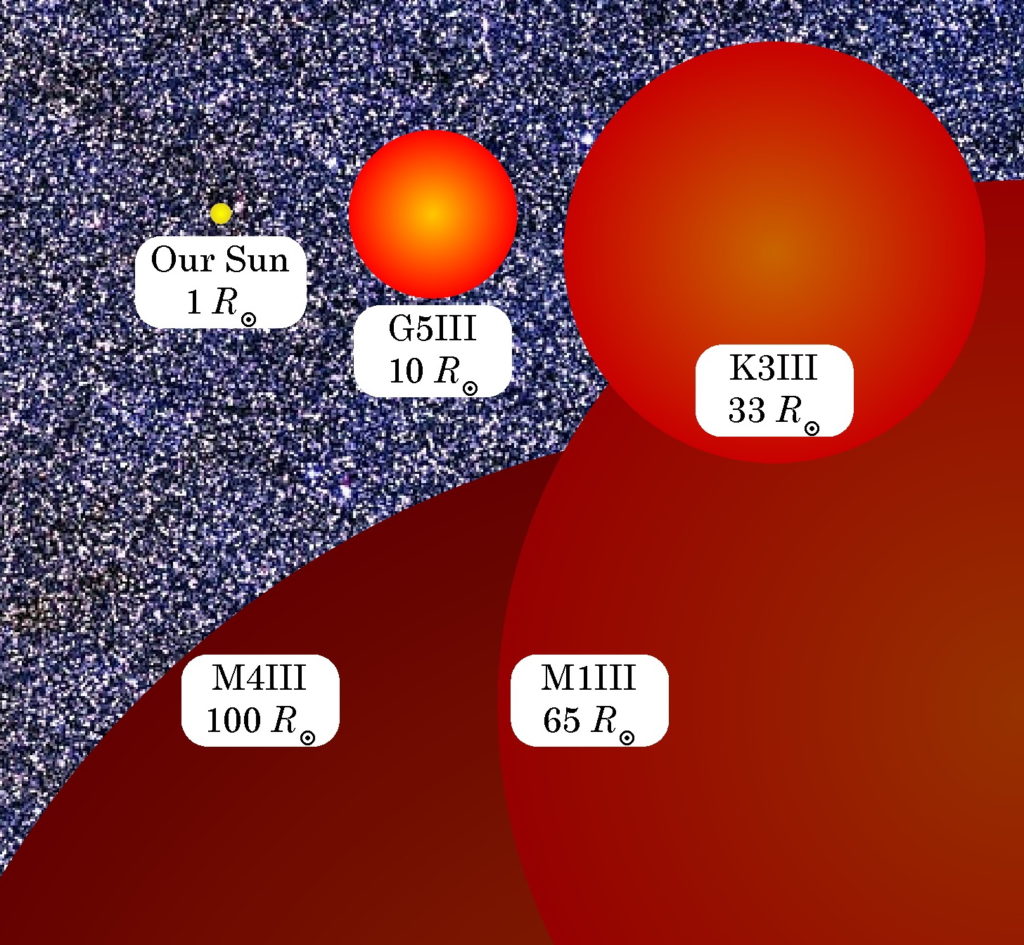
Sizes of giant stars relative to our Sun. Going from the G-type to K-type to M-types, giant stars get progressively redder (cooler) and larger. Late M-type giants are more than 100 times the size of our Sun.
Flagstaff, AZ. – In a study that is by far the most accurate of its kind, a team of scientists led by Lowell Observatory’s Gerard van Belle has now directly measured the temperatures and sizes of 191 giant stars. The results were published in a 310-page paper that the authors anticipate will serve as a standard reference for years to come. One application of the study involves clarifying the ultimate fate of the Sun.
A giant star is a type of star that is much larger and brighter than other stars of similar temperatures. In 1997, a team of astronomers began making high-precision measurements of such stars using the Palomar Testbed Interferometer in California. They continued collecting data through 2008, when the facility closed.
The Palomar work was supplemented with observations by both professional and amateur astronomers using telescopes at Lowell Observatory, as well as a privately owned telescope. While this type of study has been done before, none come close in terms of scale or accuracy. Van Belle said, “At best, every other study is only half this size, in terms of the number of stars.”
In evaluating the resulting data, the team determined temperatures at an accuracy two to four times higher than in previous studies. Van Belle explained, “This means that if you tell me what color a star is or if you tell me what type of star it is, I can tell you its temperature and be much more confident in that.”
The data set has many potential applications. For instance, knowing a star’s size allows astronomers to infer the sizes of planets detected around them, and higher precision measurements allow for more accurate size estimates.
A closer-to-home application involves the Sun. Increasingly accurate measures of the sizes and temperatures of giant stars can challenge, guide, and improve the models that scientists create to predict stars’ life cycles. The Sun will turn into a giant star in about five billion years—when it swells 10 to 100 times its current size—and this newest data will help clarify its ultimate fate, as well as give insight into its current physical processes.
Van Belle pointed out that this type of long-term research project is typical of Lowell Observatory. “This is very much in Lowell’s blood,” he said. “It’s very hard to do this work anywhere else—we have our own telescopes and control the time. We have it in our DNA to support long-term projects.”
The research was supported by NASA, the National Science Foundation, and Lowell Observatory’s Slipher Society. The paper was published in The Astrophysical Journal https://iopscience.iop.org/article/10.3847/1538-4357/ac1687
###
About Lowell Observatory
Lowell Observatory is a private, nonprofit 501(c)(3) research institution, founded in 1894 by Percival Lowell atop Mars Hill in Flagstaff, Arizona. The observatory has been the site of many important discoveries, including the first detection of large recessional velocities (redshift) of galaxies by Vesto Slipher in 1912-1914 (a result that led ultimately to the realization that the universe is expanding), and the discovery of Pluto by Clyde Tombaugh in 1930. Today, the observatory’s 14 tenured astronomers use ground-based telescopes around the world, telescopes in space, and NASA planetary spacecraft to conduct research in diverse areas of astronomy and planetary science. Lowell Observatory currently operates multiple research instruments at its Anderson Mesa station, east of Flagstaff, and the 4.3-meter Lowell Discovery Telescope near Happy Jack, Arizona. Prior to the pandemic, the observatory also welcomed more than 100,000 guests per year to its Mars Hill campus in Flagstaff, Arizona, for a variety of educational experiences, including historical tours, science presentations, and telescope viewing.
###
Media Contact
Kevin Schindler, Lowell Observatory
(928) 607-1387
kevin@lowell.edu